Quick Look
Grade Level: 9 (9-12)
Time Required: 45 minutes
Expendable Cost/Group: US $0.00 This activity requires use of a non-expendable (reusable) LEGO MINDSTORMS robot kit; see the Materials List for details.
Group Size: 3
Activity Dependency: None
Subject Areas: Physical Science
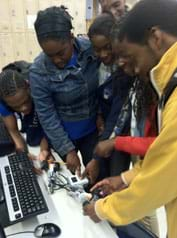
Summary
Students are introduced to the concepts of torque, power, friction and gear ratios. Teams modify two robotic LEGO® MINDSTORMS® vehicles by changing their gear ratios, wheel sizes, weight and engine power, while staying within a limit of points to spend on modifications. The robots face each other on a track with a string attaching one to the other. The winning robot, the one with the best adjustments, pulls the other across the line.Engineering Connection
Mechanical engineers encounter torque in many systems, such as cars. Gear ratios also play important roles in the operation of cars, which use automatic and manual transmissions to adjust the torque output to suit the terrain. Knowledge of these concepts enables systems to run more efficiently and safely.
Learning Objectives
After this activity, students should be able to:
- Identify gear ratios and the significance of each to the solution of a problem.
- Explain that the solution to an engineering problem may be reached by many ways.
- Work with others to solve a problem.
- Describe the concept of torque and its application to the activity.
Educational Standards
Each TeachEngineering lesson or activity is correlated to one or more K-12 science,
technology, engineering or math (STEM) educational standards.
All 100,000+ K-12 STEM standards covered in TeachEngineering are collected, maintained and packaged by the Achievement Standards Network (ASN),
a project of D2L (www.achievementstandards.org).
In the ASN, standards are hierarchically structured: first by source; e.g., by state; within source by type; e.g., science or mathematics;
within type by subtype, then by grade, etc.
Each TeachEngineering lesson or activity is correlated to one or more K-12 science, technology, engineering or math (STEM) educational standards.
All 100,000+ K-12 STEM standards covered in TeachEngineering are collected, maintained and packaged by the Achievement Standards Network (ASN), a project of D2L (www.achievementstandards.org).
In the ASN, standards are hierarchically structured: first by source; e.g., by state; within source by type; e.g., science or mathematics; within type by subtype, then by grade, etc.
International Technology and Engineering Educators Association - Technology
-
Demonstrate that creating can be done by anyone.
(Grades
Pre-K -
2)
More Details
Do you agree with this alignment?
-
Requirements for design are made up of criteria and constraints.
(Grades
6 -
8)
More Details
Do you agree with this alignment?
-
Design an appropriate technology for use in a different culture.
(Grades
9 -
12)
More Details
Do you agree with this alignment?
State Standards
Texas - Math
-
select tools, including real objects, manipulatives, paper and pencil, and technology as appropriate, and techniques, including mental math, estimation, and number sense as appropriate, to solve problems;
(Grades
9 -
12)
More Details
Do you agree with this alignment?
Texas - Science
-
assess the relationship between force, mass, and acceleration, noting the relationship is independent of the nature of the force, using equipment such as dynamic carts, moving toys, vehicles, and falling objects;
(Grades
9 -
10)
More Details
Do you agree with this alignment?
-
demonstrate and apply the laws of conservation of energy and conservation of momentum in one dimension;
(Grades
9 -
12)
More Details
Do you agree with this alignment?
Materials List
Each group needs:
- 1 LEGO robot with interchangeable parts including gears, extra LEGO for weights, and wheels; see Figure 1; LEGO MINDSTORMS EV3 robot, such as EV3 Core Set (5003400) at https://education.lego.com/en-us/products/lego-mindstorms-education-ev3-core-set/5003400#lego-mindstorms-education-ev3
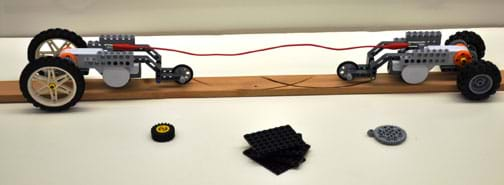
Alternative: LEGO MINDSTORMS NXT Set:
Note: This activity can also be conducted with the older (and no longer sold) LEGO MINDSTORMS NXT set instead of EV3; see below for those supplies:
- 1 LEGO robot with interchangeable parts including gears, extra LEGO for weights, and wheels; see Figure 1; LEGO MINDSTORMS NXT robot, such as the NXT Base Set
To share with the entire class:
- track to keep robots in alignment, such as a strip of wood (see Figure 1)
- string to tether together the two robots
- computer and projector to show the Tug of War Battle Bots Presentation (EV3 version) or the Tug of War Battle Bots Presentation (NXT version)
Worksheets and Attachments
Visit [www.teachengineering.org/activities/view/nyu_activity1_battlebots] to print or download.Introduction/Motivation
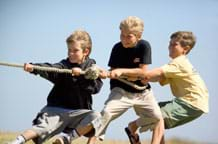
(In advance, be prepared to show students the 16-slide Tug of War Battle Bots Presentation, a PowerPoint® file.)
Anyone who has ever played tug of war knows that the winner is usually the stronger or heavier of the two and if you have watched drag racing, you know that the fastest car wins the race. So if we combined the two activities, what properties would we find in the winning car? (Listen to student suggestions, and then list the characteristics of both winners at each activity.) Sports cars go FAST (have speed), but cannot pull any weight. Big trucks and tractors can PULL heavy loads (have power), but cannot go fast. And—that is exactly what this activity is about. We will build our own tractor pullers out of LEGO to try to pull our opponents over the line.
What makes these cars so powerful or fast? Have you heard of concepts like torque, power, friction or gear ratio? Well, let's learn what we need to know to prepare our battle bots for a tug of war game against each other. (Show the presentation to review the concepts.)
For today's challenge, each team will be given a specific amount of points that you can spend modifying your robots. Parameters can include, power, wheel size, gear ratio and weight. We will put the bots on a track and whichever team pulls the other's robot over the mid-line wins the game.
Procedure
Overview
To understand what makes a successful machine, students need an understanding of torque, power, gear ratio and friction. Use the information and images provided in the Tug of War Battle Bots Presentation, a PowerPoint® file, and in this section to introduce the concepts to students:
- First, explain torque in a simple manner, perhaps using a seesaw analogy (force x lever arm).
- Then, explain the power of the engine as work/time, or in a simpler form for this activity, as a number value for the LEGO MINDSTORMS interface.
- Next, explain gear ratio, building on the concept of torque.
- As a simple warm-up activity, measure the diameters of gears and make gear ratios. Then explain the characteristics of each. For example, a large gear ratio enables large torque, but translates to low speed, and vice versa.
- Finally, demonstrate the problems in design when a car does not have enough friction to support the turning of its wheels, such as cars on ice or drag racers burning the rubber of their wheels.
Lecture Information
(The following information is also provided in the presentation.)
Concept of Gear Ratio: You see gears in just about everything that has spinning parts. For example, car engines and transmissions contain lots of gears. If you looked inside a VCR, you would see that it is full of gears. Wind-up, grandfather and pendulum clocks contain plenty of gears, especially if they have bells or chimes. You probably have an electrical power meter on the side of your house, and if it has a see-through cover, you can see that it contains 10 or 15 gears. Gears are everywhere that you find engines and motors producing rotational motion.
How do we figure out gear ratios? Here's an example: If you have two gears, a smaller one with 13 teeth and a larger one with 21 teeth, the gear ratio is 21/13 or 1.62/1 or 1.62.1. In other words, it takes 1.62 revolutions of the smaller wheel to make the larger wheel turn one revolution.

Gears are used for two basic purposes: to increase/decrease rotation speed, or to increase/decrease torque. To increase speed and reduce torque, use a large drive gear coupled to a smaller driven gear. This is called gearing up and in this case, the large gear drives the small gear. The small gear turns faster; speed increases and torque decreases.
To reduce speed and increase torque use a small LEGO gear turning a larger gear. This is called gearing down, and in this case, the small gear drives the large gear. The large gear turns slower; speed decreases and torque increases.
Concept of Torque: Torque is an applied force on a lever arm. As an example, a wrench acts like a lever. The longer the handle on the wrench, the less pushing you have to do to turn a nut. A wrench with a shorter handle is harder to turn. (T = r x F) So, in order to figure out how to make things turn easier you need to know two things:
- The distance from the end to the center of the thing you are trying to turn, and
- How much force you need to push on the handle in order to make it turn
Where is the torque on your robot? The motor on your robot uses a set amount of torque to turn the wheels. The driver gear uses torque to turn the follower gear.
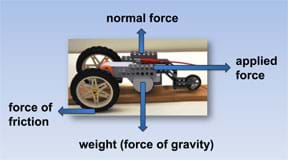
Concept of Weight and Normal Force: The weight of an object is not the same as its mass; the weight is defined as the force exerted by gravity. For an object to stay on the ground, the force of gravity must be offset by an equal force pushing back—we call this force the normal force—the Earth is pushing back against gravity (see Figure 2).
Concept of Force of Friction: Friction is the resistance encountered by two touching materials. When you push on a surface with your hand, you notice that it becomes hard to slide your hand along the surface. Why? The reason is friction. The harder you push, the harder it is to slide your hand. It might get so difficult to slide it that it is altogether impossible to move! The way the frictional force works is a little trickier than the other forces we've dealt with so far. If the two objects are not pushing against each other, no friction exists. But, the harder they're pushed together, the greater the friction. An object with a lot of weight makes a lot of friction with the surface of the ground.
The Challenge and Rules: Today's challenge is to design a vehicle with maximum pulling power, in order to pull an opponent's robot over the middle line, and to understand the concepts of friction, torque and gear ratio while playing games.
In the tug of war game, each team is given an identical LEGO robot to modify. Modifications can alter: the amount of power provided to motor, robot weight, gear ratio and wheel size. Before any modifications, the robots come with: large wheels, 1:1 gear ratio, no added weight and 75 power. At the beginning of the challenge, each team receives the same amount of points (50) to spend on modifications to the robot; every modification costs a certain amount of points (see Table 1). After design modifications are completed, the tug of war begins. The winning robot is the one that wins the game and costs the least.
Before the Activity
- Gather materials and prepare to show the Tug of War Battle Bots Presentation a PowerPoint® file.
- Decide on a point system for teams to "pay" for modifications. For example, give each team 50 points and use the costs shown in Table 1 to make changes to the robots. For example, adding more weight to a robot costs one point for each LEGO sheet added.
- Organize the class into teams.
- Show students how to interchange parts to their LEGO vehicles so that they can make adjustments.
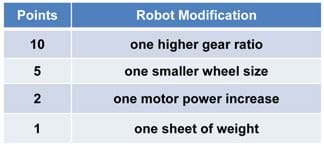
With the Students
- Introduce students to this engineering challenge using the Introduction/Motivation section and the presentation.
- Review the challenge and rules with the students, including how many points are allowed per team and how many points each modification "costs."
- Have students build their robot vehicles (see Figure 3) and test for design flaws, but no practice runs pulling objects. Have each team keep track of its costs for robot modifications.

- Hold the tug of war contest. Fasten string to each vehicle and commence pulling until one vehicle is pulled over a line. Use the mid-line as the pull line, or a shorter distance, if necessary.
- If more than two groups, do round robins or tournament format to determine a winner, with consideration for modification costs.
- To conclude, have teams each do quick class presentations to summarize their design strategies and outcomes (as described in the Assessment section). Discuss the design of each racer and the characteristics that made it successful or unsuccessful in the competition.
Vocabulary/Definitions
angular velocity: Revolutions of a spinning axis over a designated time.
circumference: Length around the perimeter of a circle.
friction: A reactive force dependent on the weight of an object and the relationship between two touching surfaces.
gear ratio: The relationship of the output gear's teeth (or diameter) over the input gear's teeth (or diameter).
motor[motora]=: Command to give motor A a desired power.
power: force x distance (parallel), torque x angular velocity
radius: Half the diameter of a circle.
robot: A multifunctional, reprogrammable manipulator designed to perform a variety of tasks.
teeth: Small ridges that make up the circumference of a gear.
torque: force x a perpendicular distance from a measured point
tug of war: A contest in which two teams pull on opposite ends of a rope until one team drags the other over the starting mid-line.
wait1msec(): Command to wait () milliseconds.
Assessment
Pre-Activity Assessment
Conceptual Identification: Before beginning the activity, gauge the class' understanding of force, gear ratios and friction with the following exercises:
- Force/gear ratios/torque/speed: Draw two lines of different lengths on the classroom board. Ask students: If a force was applied, which one has more torque about its axis of rotation? Now translate that to simple gear ratios. See if students understand that different gear ratios can provide different torques, which can translate to different speeds.
- Friction/wheels/weight: Have students try to pull across the desk a piece of paper with a stapler on it. Now try it with a pencil. Which one is harder to pull? Why? Now translate that concept to wheels and how they need to have enough weight to have friction make them move.
Activity Embedded Assessment
Does It Do What I Want It to Do? As students are designing and modifying their robotic vehicles, tell them to run the vehicle for a while and see how fast it may go compared to the others. Is this a race? Can I pull more if I am traveling slower, or vice versa? Make sure students understand that sports cars can go fast (have speed), but cannot pull any weight. Conversely, big trucks and tractors can pull heavy loads (have power), but cannot go fast. Knowing this will help them design vehicles that perform well in the challenge.
Post-Activity Assessment
Wrap-Up Quick Presentations: Have each group present to the class its design strategy, creating an opportunity to discuss the many variations and results. What gear ratios did they use? How big were the wheels? Did they have enough weight? What were the characteristics of each vehicle? Which is the fastest or slowest? Why? Which one finished ahead of the others? Which modifications had the best results and lowest costs? Discussing their designs helps students recognize flaws and think of alternate solutions to their problems. Point out that—as with most engineering challenges—many successful solutions can exist to a single problem.
Homework
Take It Home: Assign students to find real-life examples of gears outside of school. Draw diagrams or take photographs. Count the teeth and calculate the gear ratios. What are the purposes of these gears? Have them share what they find with the rest of the class.
Activity Scaling
- For lower grades, reduce the amount of modifications teams are permitted to make to their robots. If the physics topics appear too advanced, focus primarily on the concept of gear ratio and the advantages that the robot vehicles can gain from different gear ratios.
Subscribe
Get the inside scoop on all things TeachEngineering such as new site features, curriculum updates, video releases, and more by signing up for our newsletter!More Curriculum Like This

Students are introduced to gear transmissions and gear ratios using LEGO® MINDSTORMS® EV3 robots, gears and software. They learn how to build the transmission part of a vehicle by designing gear trains with different gear ratios. Once students learn the principles behind gear ratios, they are put to...

Students are introduced to an important engineering element—the gear. Different types of gears are used in many engineering devices, including wind-up toys, bicycles, cars and non-digital clocks. Students learn about various types of gears and how they work in machines.

Student teams are challenged to design a gear set that will lift a given load as quickly as possible. They test and refine their designs to find the ideal gear ratio, one that provides enough torque to lift the weight while still achieving the fastest speed possible.
Copyright
© 2013 by Regents of the University of Colorado; original © 2010 Polytechnic Institute of New York UniversityContributors
Zachary Nishino; Karl Abdelnour; Irina IgelSupporting Program
AMPS GK-12 Program, Polytechnic Institute of New York UniversityAcknowledgements
This activity was developed by the Applying Mechatronics to Promote Science (AMPS) Program funded by National Science Foundation GK-12 grant no. 0741714. However, these contents do not necessarily represent the policies of the NSF, and you should not assume endorsement by the federal government.
Last modified: October 16, 2020









User Comments & Tips